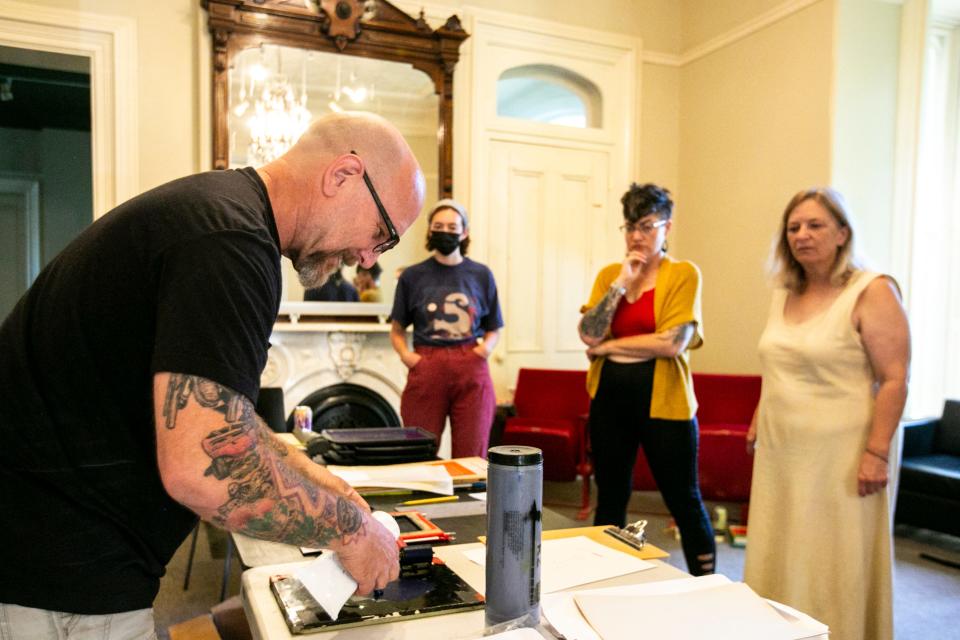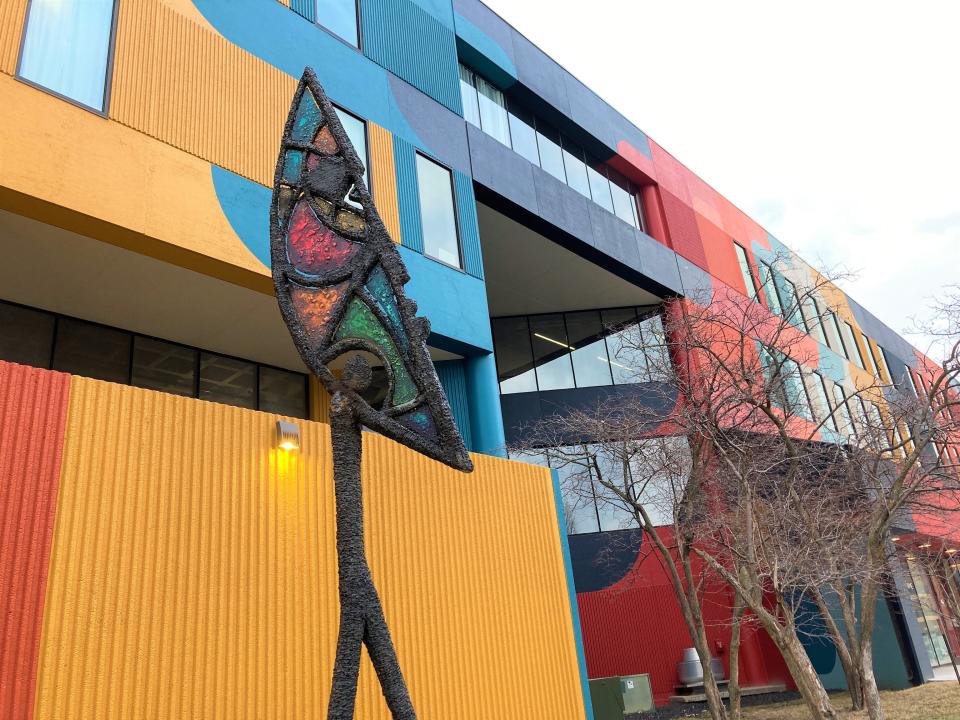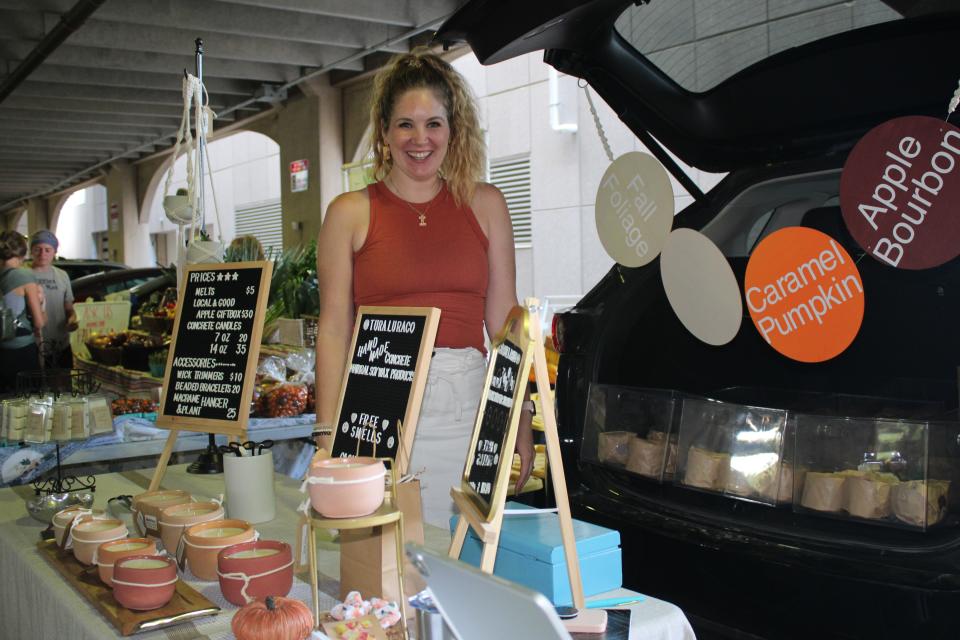Iowa City visual artists experience challenges of time and money, but solutions exist. Take a look.
Erika Christiansen, founder of Tura Lura Co. in Iowa City, sought a solution to a challenge she knew she wasn’t alone in facing.
When an artist grant in 2021 catapulted Christiansen’s handmade candles into what is now a local business offering other goods, she found that other makers and artists wanted their goods to be stocked on the shelves of local stores, but getting that to happen wasn’t so simple.
The candlemaker, former dancer and educator began thinking of ways she could help. She hoped the Builders + Backers Idea Accelerator program she joined earlier this summer would provide an answer.
“We pride ourselves on shopping small. We pride ourselves on being the greatest city for the small arts. How do you connect and stock the shelves of our local places with our local artists?” she told the Press-Citizen.
As Iowa City works to be the self-proclaimed "Greatest Small City for the Arts," it must confront challenges for visual artists in pursuit of their craft. Still, these creatives find community, mentorship and opportunities to support their work.
In a three-part series, the Press-Citizen is exploring the visual artists that live and work here; the challenges some face in pursuit of their creative work; and what can be done to better support artists in Iowa City.
In the third installment, the Press-Citizen highlights what aids visual artists; creating spaces for artists to connect and learn about paid art and teaching opportunities; and looks at cities elsewhere who are supporting local artists in unique ways.
Part 2: Iowa City visual artists seek more galleries, affordable studios, entrepreneurial lessons
What does a healthy arts scene looks like? One former chief curator had some ideas
Renny Pritikin was the chief curator of San Francisco's Contemporary Jewish Museum. He was the director of the Richard L. Nelson Gallery and the Fine Arts Collection at the University of California, Davis from 2004-12.
Pritikin wrote “Prescription for a Healthy Art Scene” and listed 23 points that make one.
His “prescriptions” include:
Teaching opportunities that help support the pool of artists
Activate art schools that feed into the pool of artists and give artists teaching opportunities
Studio space that’s affordable
Alternative spaces that give exhibition and residency opportunities for new art and ideas
Social space where new ideas are being generated about art, society and the role of art
Artists-in-residency opportunities
Opportunities for public art (city or private)
John Engelbrecht, director at Public Space One who shared a copy of Pritikin's work with the Press-Citizen, said he’s returned to Pritikin’s prescriptions “a lot” in the 10 years since he first came across them.
More: Iowa City art installation takes listeners to 10 parking lots, creating discovery and belonging
How different Iowa City organizations, community members address the challenges artists face
Some of Pritikin’s points are reflective of work already being done in Iowa City.
Public Space One has been offering artists to teach paid community workshops for teens or adults since 2013. In 2020, the nonprofit was able to increase pay and make it “a little bit fairer” to reflect the expertise that people bring, said Kalmia Strong, programming director.
“Thanks to the Iowa Arts Council, (PS1) was actually (able to) do a project where the workshop teachers work together sort of as a cohort and did some more reflection and planning on teaching, so that they actually were getting supported and becoming hopefully better teachers,” she said.

Public Space One is planning to provide more professional skills-based training with artist resource manager and artist Hannah Givler.
Paying artists directly is central to how PS1 does things, Strong said, but she added that the nonprofit also wants to create a space where people feel like they don’t have to monetize themselves or their work if that’s their preference.
People are “eager” for community connection in their creative practice, something that is “incredibly important and valuable in a thriving arts community” Strong said.
Maura Pilcher is the director of the Grant Wood Art Colony at the University of Iowa.
Named after Iowa’s famous artist, the colony provides three fellowships in painting and drawing, printmaking and interdisciplinary performance.
Fellows are provided a furnished living space in Iowa City, receive a teaching salary and benefits — fellows only teach one class a semester to ensure adequate time for their creative work — as well as studio space for their work and a stipend for materials.
The fellowship originated when artist Jim Haes purchased Grant Wood’s Iowa City home and wanted to use it as a tool to bring Wood’s legacy back to the university, Pilcher said.
More: 'Anybody can be part of it': Iowa City artists don costumes and spread joy in colorful march
Haynes learned what challenges artists face, as well as what challenges the University of Iowa’s art program faces, she said.
“How can we use that and model something that meets both those goals of bringing Grant Wood’s legacy back to campus as well as benefiting the arts scene, not just in Iowa City, but in Iowa as a state and enhancing the reputation of arts in the state?” Pilcher said. “He looked at what made Grant Wood successful, and he decided it was (having) that time and space.”
Pilcher said in 2019 the colony hosted a public art residency over spring break that included lessons on budgeting and finances and developing professional skills for working artists.
Pilcher recalled a few artists sharing with her that they’ve never been taught how to represent themselves at a gallery, or how to do the “business side of things” in their creative pursuits.
Using responses from more than 90,000 alumni across America who pursued an arts major, 71% said entrepreneurial skills were “very” or “somewhat important” to their profession, but only 26% reported their institution helped them develop entrepreneurial skills “some” or “very much,” according to a 2015 Strategic National Arts Alumni Project report.
But the program providing time was equally important to almost all the artists, according to Pilcher, saying they felt they were able to take a “pause” and not be pressured to make work.
As Grant Wood Art Colony removes financial and time barriers to make art, the Black Liberation Space in Iowa City provided a space dedicated to communities of color that could create comfortably.
More: Plan your visit to Iowa City's new Stanley Museum around these 9 pieces of art
Andre Wright, an artist, activist and founder of the Black Liberation Space, said one barrier he could speak to was the difficulties of being Black and entering into a white space and be a “true artist” and create “art based on your own diaspora.”
People had told him that the reason they’d supported the Black Liberation Space, a temporary downtown Iowa City space that hosted Black, Latinx, Indigenous and people of color who were creatives, was because “there was artists in there that looked like them.”
“They could relate to them,” he said. “They can make mistakes together and not be judged, and they didn't have to conform to the space because they were surrounded by other people that weren't of their background.
“So I feel like having spaces not necessarily that are just geared to Black people, but having more multicultural spaces where you can get a variety, and it's not always led by the white population, is just uber important to have in our community."
Studio spaces, an arts app and a guaranteed income: Innovation at different levels across a few cities in America
Across America, the value of arts and how they are supported is being addressed in varying ways — including in two Iowa cities.
Portland, Maine, is home to 66,000 people and a strong arts scene.
Dinah Minot is the executive director of Creative Portland, the city’s official arts agency with a goal to sustain local creatives. Some of its recent work includes that it's created an artist relief fund during COVID-19 and disbursed over $95,000 to support artists.
The organization launched a Creative Portland App earlier this year that allows users to access a list of art galleries, music venues and see events happening in town. Arts and cultural organizations can create and promote their own listings, while local businesses can use the app for sponsorship opportunities while supporting the arts.
It's part of the nonprofit’s interest in growing access to arts both for community members and artists, and an arts scene residents are proud of, Minot said.
Creative Portland’s annual arts and culture summit, which takes place Sept. 20 this year, will explore ways to increase visibility for artists, funding opportunities for artists and arts organizations and more, with artists, students, nonprofit leaders, private business leaders and more invited to the summit.

Far closer to Iowa City, Mainframe Studios in Des Moines began to provide permanent, affordable workspaces for artists, owner Justin Mandelbaum told the Des Moines Register last year.
Mainframe Studios is a nonprofit that houses the operations of artists across numerous mediums. That includes designers, photographers, painters, a radio station and more.
The nonprofit conducted a demand study and collected responses from artists, arts organizers and community supporters. It found that a majority of people were working out of their home, that there was a clear demand for this space among visual artists, craftspeople and performers, and that a majority were interested in both participating in an open studio event and displaying their work in a gallery, according to Mainframe Studios.
Mainframe Studios has space to rent for events, art classes, exhibitions and more, something that echoes what some artists in Iowa City had hoped to find for the community. Even closer is CSPS in Cedar Rapids, formerly Legion Arts, which provides multiple galleries (for about 15 to 20 exhibits a year, according to the CSPS website), performing artists space including a theater, and space to conduct workshops or meetings.
Compensation, whether it be fair to the time and materials involved beyond the end production or just payment at all, remains a challenge.
In New York, Creatives Rebuild New York is a three-year, $125 million investment that will go toward supporting artists, including a guaranteed income program for artists.
For 18 months, 2,400 artists will receive $1,000 per month.
“We must move beyond valuing the artistic product and begin to value the humanity of the artist. Artists need and deserve to be paid predictable and regular incomes,” according to CRNY’s website.
As for those whose mediums could benefit from nontraditional art spaces, like Iowa City artist Kai Kiser, who works in digital art, a newer exhibition space in Santa Fe, New Mexico, is exploring just that.
Art Vault exhibits digital art, and the gallery, according to its website, is one of the few digital art collections open to the public in the country.
Will these ideas work in Iowa City? In one case, the answer is not as clear
Over a decade ago, a group of local artists was in the process of a creating a community arts center in Iowa City which, if successful, could have been an answer to some artist challenges: plenty of affordable studio spaces, places to take or teach classes and share expertise and equipment.
The group, led by Patricia Knox, was called A Home For the Arts!
While that group emerged, Arts Iowa City, the oldest arts nonprofit in Iowa City that dates to 1975, had experienced its own need for a home, facing basement evictions (and subsequent building demolitions) and relying on businesses to offer their spaces so they could host programing.
The two groups later merged, now known as the ArtiFactory. Until 2020, the group had made some headway toward the goal of creating an Iowa City communal arts center.
Knox and other AHA! members participated in venture school through the University of Iowa and later recruited now ArtiFactory Building Committee member Dan Cummins.
They interviewed community members and artists to determine if there was an interest in this space. They found tha the answer was yes, Cummins told the Press-Citizen.
That didn’t answer the question of financial viability, Cummins said.
The ArtiFactory identified the building at 1423 Waterfront Drive in Iowa City, formerly the Bochner Chocolate Factory building, as a possible location for the vision.
The team had a feasibility study created, which was shared with the Press-Citizen. Completed in 2020, the study found:
36 artists expressed interest in studios
92% of responses felt a community art center would be of some benefit to the community, though other responses questioned its feasibility as well as the timing of the project
32% of responses felt the scope of the project was too large, citing concerns over funding and administrative oversight of the project
72% would endorse a campaign for a new art center
Then, the COVID-19 pandemic hit. The building became Black & Gold Climate Controlled Storage, and the efforts of the ArtiFactory lost momentum.
“I think we've never really been able to answer this question, is: can an organization on its own lift something as substantial as what we envisioned? And, of course, that assumes that something as substantial as we envisioned is what the community wants,” Cummins said.
He said that there are many models out there regarding a community arts space, but most “are predicated upon some kind of financial support from the city, county, state level to get you in the door.”
Should the arts thrive, everyone must be all in
In 2002, Public Space One was founded. Its origins lie as a venue to provide access for “creative endeavors of all sorts,” Engelbrecht said.
It was a heavily experimental place, something it's retained all these years later.
It’s that experimentation that makes it unique to Iowa City, and unique to the artists who find support there.
Engelbrecht said PS1 tries to be an “artist resource center,” acting as the bridge between artists and the public.
But there are a lot of artists, Engelbrecht said, that he believes have figured out how to operate without having to plug into a local arts scene.

There are also creatives like Christiansen, who is tapping in local makers and local business owners to expand on the idea of shopping small.
She spent the summer working through her idea, a possible solution, to the challenge of getting local artists’ work into local businesses.
Research, in her personal business journey and in the Builders + Backers program she participated in, was essential.
Time and energy for many folks is often split between other responsibilities, making it difficult to put all their resources into finding a local business who’d want to sell their work, she said.
How to start a business is “daunting” when folks haven’t taken business or entrepreneurial classes, she said.
On Sept. 26, Christiansen’s idea will transform into something tangible.
She has created an expo called Local + Good, which will be held at Merge in Iowa City, for people to connect and to foster partnerships between the locals who are making goods, and the business owners who want to help sell products.
Strong said a healthy ecosystem is one where multiple organizations are creating such a space effectively, pointing to the work the ArtiFactory does in providing educational arts programming that PS1 doesn’t offer. Or Willow Creek Theatre Co., which provides opportunities, and compensation, for folks involved in the performing arts.
It echoes a sentiment of Wright’s, who reflected on the idea of creating accessible spaces where artists can comfortably work.
“I also think this can’t be led by one organization,” he said. “I think that it needs to be a multitude of people, organizations, community that needs to wrap their arms around and support underrepresented artists, because those are the people who aren't getting the recognition.”
Paris Barraza covers entertainment, lifestyle and arts at the Iowa City Press-Citizen. Reach her at PBarraza@press-citizen.com or (319) 519-9731. Follow her on Twitter @ParisBarraza.
This article originally appeared on Iowa City Press-Citizen: Iowa City organizations, residents support artists as new models arise

